| |
California |
| Click the points of the map below to learn more

|
| |
 |
Oakland is the third largest city in the "Bay Area" behind San Jose and San Francisco. It was founded in 1852 as a railroad terminus during the California Gold Rush. In 1906, its population doubled after refugees from the San Francisco Earthquake arrived in town. In the 1920's, the city became a major manufacturing center for ships, automobiles, and metals.
Today, Oakland's shipping port is the third largest on the west coast. Just to the north of Oakland lies Berkeley. Berkeley is best known as the home of the University of California at Berkeley, the site of the nation's two nuclear weapons labs.
Back to Map
|
| |
|
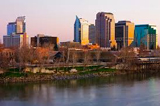 |
Sacramento
Sacramento was founded in 1839 by John Sutter, an immigrant from Switzerland who established a stockade and trading colony known as Sutter's Fort. After gold was discovered in the region in 1848, the town's name was changed to Sacramento, after the Sacramento River. It was the second incorporated city in California.
Perhaps no other city was as essential to the gold and land rushes of the 1850's as Sacramento. Thousands of settlers descended upon the region, after traveling the 2,000 mile long California Trail, in the hopes of finding fortune in the gold mines. Sacramento was made capital of California in 1855 and soon became a very important city. It was made the western terminus of the Pony Express and first Transcontinental Railroad.
Today, Sacramento's population is booming, as people leave the San Francisco Bay area in search of lower housing prices. In addition, the area has recently received an influx of immigrants.
Back to Map |
| |
|
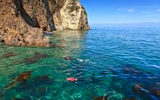 |
Channel Islands National Park
Channel Islands National Park, located just outside of Los Angeles, is comprised of five islands full of natural wonders. Although only four mammals are endemic to the islands, over 2,000 species of plants and animals are found within the park, 145 of which are found nowhere else on earth. More than half of the park's 250,000 acres are under the ocean. The park's waters are home to the Blue Whale, the largest animal to have ever lived on earth.
Back to Map |
| |
|
 |
Sequoia and Kings Canyon National Parks
Sequoia and Kings Canyon National Parks, located in eastern California, feature the famous Giant Sequoias - huge trees that can grow to over 300 feet in height. One of the trees, the General Sherman Tree, is the largest tree on earth. It is over 274 feet high, and over 100 feet around. It is located in the section of the park known as the "Giant Forest", where five of the ten largest trees in the world are located. The park also contains Mt. Whitney - the highest peak in the continental USA.
Back to Map |
| |
|
 |
Death Valley National Park
Death Valley National Park, located in eastern California, is one of the most arid places on earth. It also contains the second lowest point in the western hemisphere (282 feet below sea level). Summer temperatures in the valley average well over 100 degrees, and the region receives a little less than two inches of rain per year. The park, however, also features incredible sand dunes, colorful badlands, rocky canyons, and hearty animals that have adapted to the harsh climate.
The valley is punctuated by unusual rock formations and towering mesas and buttes. A mesa is an elevated area of land with a flat top, and a butte is an isolated hill with steep sides and a small, flat top.
Back to Map |
| |
|
 |
Redwood National Park
Located in the cool, misty climate of northern California's Coast Range, Redwood National Park is a surreal place. The ancient redwood trees that populate the park are among the world's most spectacular sights. Many of the trees exceed 300 feet in height and 20 feet in width. Some are nearly 2,000 years old!
Back to Map |
| |
|
 |
Los Angeles
Los Angeles was founded in 1781 as Mission Nuestra Señora Reina de los Angeles by 46 Mexican settlers. After the area was ceded to the United States following the Mexican-American War, the railroads came to town in 1876, and oil was found in 1892. The population quickly exploded and by 1923 Los Angeles was producing 25 percent of the world's petroleum. Los Angeles hosted the Summer Olympics in 1932 and 1984.
Today, Los Angeles, otherwise known as "The City of Angels," or simply as "L.A.," is the nation's second largest city, and home to major movie studios, television networks, Hollywood, and scores of famous personalities, actors, and actresses. In addition, Los Angeles is the largest manufacturing center in the United States and features the nation's most important port. Despite its reputation as a mecca of entertainment, Los Angeles is one of the nation's most polluted and congested cities.
Back to Map |
| |
|
 |
Anaheim
Anaheim was founded in 1858 by a group of fifty German grape farmers. Today, it is best known as the site of the DisneyLand theme park. The park, which recently celebrated its fiftieth birthday, has attracted over 500 million visitors since it opened. Anaheim also features two professional sports teams, the Angels (baseball) and Mighty Ducks (Hockey). The city boasts the largest convention center on the west coast.
Back to Map |
| |
|
 |
Lassen Volcanic National Park
Lassen Volcanic National Park, located in northeastern California at the southern limit of the Cascades Range, features all four types of volcanoes that exist on Earth.
Over 150 miles of trails provide access to volcanic wonders in-cluding steam vents, mudpots, boiling pools, volcanic peaks, and painted dunes.
Back to Map |
| |
|
 |
Joshua Tree National Park
Joshua Tree National Park, located in southeastern California, marks the junction of two deserts, the Colorado Desert and the Mojave Desert. The famous Joshua Trees inhabit the Mojave portion of the park. Joshua Trees are unusual looking trees that grow only in the Mojave Desert. They can live hundreds of years and take a human lifetime to reach full height (40 feet high). The trees were named by Mormons crossing the desert in the 1800's. They reminded them of the biblical character Joshua reaching his hands to the sky.
Back to Map |
| |
|
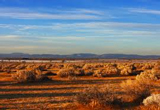 |
Mojave Desert
The Mojave desert extends through southern Nevada, northwestern Arizona, and parts of southeastern California.The region gets about six inches of rainfall per year. Most of the desert is between 3,000 and 6,000 feet in altitude. Summers are extremely hot. Some places, like Death Valley, regularly reach temperatures of 120 degrees Fahrenheit.
The Mojave is one of the most biologically rich deserts. About 2,000 species of plants have been documented.
Back to Map |
| |
|
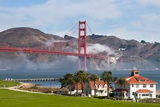 |
Golden Gate Bridge
The Golden Gate Bridge is an international symbol of San Francisco and the second largest suspension bridge in the United States. It spans a length of 1.7 miles and connects the city of San Francisco with Marin County. The bridge was opened on May 27, 1937. Today, about 100,000 vehicles pass over every day. It is part of the Golden Gate National Recreation Area, which also includes the Muir Woods and Alcatraz Island. Since its opening, over 1,300 people have committed suicide by jumping off of the bridge. 26 people have survived the jump.
Back to Map |
| |
|
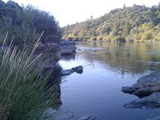 |
Sacramento River
| Length: |
377 miles |
| Source: |
Sisikiyou County, California |
| Outflow: |
Sisun Bay |
| |
|
Back to Map |
| |
|
 |
San Diego
The area that is now San Diego was first visited by Portuguese explorer Juan Rodriguez Cabrillo, who claimed the bay for Spain in 1542. In 1602, the area was renamed San Diego, after the ship of Spanish sailor Don Sebastian de Viscaíno. San Diego was incorporated as an American city in 1850, after California achieved statehood. In the early and mid 1900's, the city became a major naval port.
Today, San Diego is a rapidly growing city. It has some of the mildest weather in the nation. San Diego is home to the San Diego Zoo, one the world's premier zoological parks. It features over 4,000 animals of 800 different species, including some of the nation's only Giant Pandas.
Back to Map |
| |
|
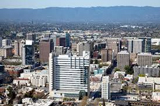 |
San Jose
Once a farming community for nearby military institutions, San Jose was the original capital of California when it gained state-hood in 1850. San Jose was one of the first incorporated cities in the state of California.
Today San Jose is a bustlingcity - the center of the region of California known as "Silicon Valley". The region gets its name from the multitudes of high-tech companies that are headquartered in the region, including Google, Yahoo, and Intel. San Jose is the largest city in northern California, and the third largest city in the state. Just to the north of San Jose
lies Palo Alto, home to Stanford University.
Back to Map |
| |
|
 |
San Francisco
San Francisco, California, is one of the nation’s top tourist destinations. It is California’s third largest city, and the 13th largest city in the United States. Because the city only occupies 47 square miles, San Francisco is the nation’s secondmost densely populated city after New York. It is nicknamed "the city by the bay," and "fog city."
Its artistic culture, Victorian architecture, cable cars, and hilly topography, make it unique among major American cities. San Francisco was founded during the height of the gold rush in 1849. That year, the city’s population swelled to 25,000, as people rushed to the city to seek fortunes. In 1906, an earthquake caused a fire that utterfly destroyed San Francisco. Today, however, San Francisco is the center of the region known as "Sillicon Valley," and is home to numerous major technology companies including Twitter, Dropbox, Uber, Pinterest, Mozilla, and Craigslist. San Francisco was also the birthplace of Levis jeans and the Gap. Surrounding areas are home to Google, Adobe, and Apple, among many others.
San Francisco features many interesting landmarks. Alcatraz Island, in San Francisco Bay, was once home to America’s most secure and infamous prison. It was nicknamed "the Rock," and it housed violent gangsters such as Al Capone and "Machine Gun" Kelly. The Golden Gate Bridge, which connects San Francisco to Marin County, California, is one of America’s most recognizable landmarks and is the international symbol of San Francisco and the Bay area. San Francisco’s Chinatown is the largest in North America and the largest Chinese community outside of China.
Back to Map |
| |
|
 |
Palm Springs
Located east of Los Angeles, Palm Springs is the nation's most famous desert resort area. It features some of the nation's best golf courses.
Many settlers came to Palm Springs because of mineral springs used by the Cahuilla Indians. The Cahuilla claimed that the mineral springs had magical powers to cure illness.
Back to Map |
| |
|
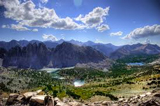 |
Sierra Nevada Range
The Sierra Nevada Range is almost entirely within California. Only a small section of the range lies in western Nevada, next to the Great Basin. Three national parks are contained within the range, as is Lake Tahoe, one of the most popular tourist resorts in California.
| Length: 400 miles |
Highest Point: Mt. Whitney - 14,494 feet.
Mt. Whitney, California's highest peak, is part of the
Sierra Nevada Range. |
| |
Back to Map |
| |
|
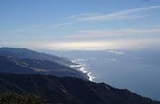 |
Coast Range
The Coast Range is the westernmost range of a series of ranges that run along the west coast of North America known as the Pacific Cordillera.
| Length: 2,300 miles |
| Highest Point: Mt. Logan (Canada) 19,850 ft. |
| |
Back to Map
|
| |
|
 |
Yosemite National Park
Located in the Sierra Nevada Range of eastern California, Yosemite is one of the oldest, and certainly one of the most spec-tacular national parks in the world. The park has too many natural wonders to describe, but features towering waterfalls, the Mariposa Grove (hundreds of Giant Sequoias), alpine valleys, and the world-famous Yosemite Valley and its amazing cliffs such as El Capitan and Half-Dome. El-Capitan is one of the most popular rock climbing locations in the world.
Back to Map |
| |
|
 |
Cascades Range
The Beautiful Cascades Range dominates parts of Oregon and Washington state. In California, the mountains only extend into the extreme northeast corner.
Length:
|
Apx. 700 miles |
| Highest Point: |
Mt. Rainier (WA) 14,411 ft |
| |
|
Back to Map |
|
Top Five Facts |
| |
1. ) If California was its own country, it would have the world's eighth largest economy. |
2. ) California's Sillicon Valley is home to tech giants such as Google, Adobe, Apple, Yahoo!, Uber, and many others. |
3. ) The first ever McDonalds opened in San Bernardino in 1940. |
4. ) California's Mt. Whitney is the highest peak in the lower 48 states (14,494 feet). |
5. ) California is the largest grape producing and wine producing state in the country. |
| |
|
| |
|
1542 - The Portuguese-born sailor, Juan Rodriguez Cabrillo, becomes the first European to explore California, landing at San Diego on September 28, 1542. He went on to discover the Catalina Islands, the sites of San Pedro, Santa Monica and the Santa Barbara Channel Islands.
1579 - Sir Francis Drake landed North of San Francisco Bay and claimed the territory for England.
1665 - José de Gálvez arrives in Mexico as Visitor General of New Spain. He launched a program of colonizing Alta California.
1767-1770 Spanish explorer Gaspar de Portola led an expedition from Mexico to make settlements in Alta California. He would eventually found San Diego and Monterrey.
1769 Junipero Serra built the first California Mission called San Diego de Alcala
1820 Early in the nineteenth century, ships from Boston began to visit the Spanish towns and missions along the upper and lower California coast.
1846 The United States invades Mexico from the east, reaching San Diego in December.
1848 California becomes a U.S. possession with the Treaty of Guadalupe-Hidalgo, which ended the Mexican War.
1849 James Marshall discovered gold at Sutter's sawmill in Coloma, along the south fork of the American River, thus kicking off the famous Gold Rush of 1849 from where the term "49ers" was born.
1850 California was admitted as the 31st state on September 9, 1850.
1860 - The Pony Express, a mail service between St. Louis, Missouri and Sacramento is established.
1869: The completion of the Transcontinental Railroad enables Americans from the eastern states to pack up and move to California. Thousands upon thousands of settlers head for the "Golden State."
1906 San Francisco earthquake and fire virtually destroys the city.
1911 Hollywood’s first film studio opened.
1937 The Golden Gate Bridge was completed and was opened to pedestrian traffic.
|
|
|





















